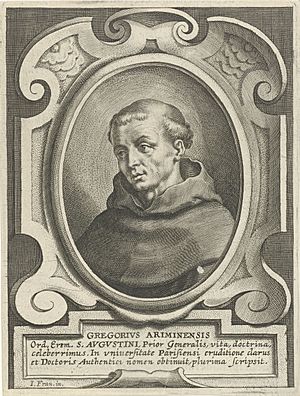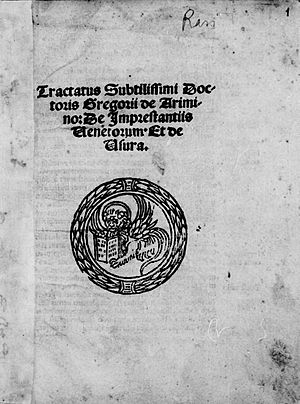Gregory of Rimini facts for kids
Quick facts for kids
Gregory of Rimini
|
|
|---|---|
 |
|
| Born | c. 1300 |
| Died | 1358 Vienna, Duchy of Austria, Holy Roman Empire
|
| Education | University of Paris |
| Era | Medieval philosophy |
| Region | Western philosophy |
| School | Scholasticism Augustinianism |
|
Main interests
|
Theology, metaphysics, epistemology, economics |
|
Notable ideas
|
Predestination, nominalism |
|
Influences
|
|
|
Influenced
|
|
Gregory of Rimini (born around 1300 – died November 1358) was a very important thinker in the Middle Ages. He was known as a scholastic philosopher and a theologian. This means he was a scholar who used logic and reason to understand religious beliefs.
Gregory was special because he brought together different ideas from universities in England (like Oxford) and France (like Paris). His work had a big impact for many years. He even influenced some of the leaders of the Protestant Reformation. People called him Doctor acutus (the sharp doctor) and Doctor authenticus (the authentic doctor).
Contents
Life of Gregory of Rimini
Gregory was born in Rimini, a city in Italy, around the year 1300. He joined a religious group called the Hermits of Saint Augustine. This was an order of monks.
In the 1320s, he went to the University of Paris to study theology. Theology is the study of religious faith and God. While there, he learned about the ideas of other thinkers.
During the 1330s, Gregory taught at Augustinian schools. These were in cities like Bologna, Padua, and Perugia. Here, he learned about new ideas from scholars in Oxford, England. These scholars included William of Ockham.
In 1342, he went back to Paris. He prepared lectures on a famous book called Sentences by Peter Lombard. He gave these lectures between 1342 and 1344. Because he knew so much about English philosophy, he shared these ideas in Paris.
Gregory became a Master of Theology in 1345. After that, he taught in Padua and Rimini. He passed away in Vienna in 1358. This was shortly after he became the leader of his religious order.
Gregory's Philosophy and Ideas
Gregory wrote several important works during his life. These included notes for his lectures and letters about governing his order. His most important writings are his lectures on the first two books of Peter Lombard's Sentences. It seems the other two books were either lost or never finished.
Many scholars who came after him copied parts of his work. People like Pierre d'Ailly were influenced by his ideas.
Influence of Saint Augustine
St Augustine was the most important influence on Gregory's thinking. Gregory studied Augustine's writings very carefully. He read them more deeply than many scholars before him.
Gregory strongly followed Augustine's ideas about certain religious beliefs. He was known for his strong views on these topics.
Understanding Reality: Nominalism
Gregory of Rimini had a special way of looking at nominalism. This idea deals with how we understand things in the world. He thought that trying to understand physical reality by using "abstract objects" didn't make sense. Abstract objects are ideas or concepts, like numbers or shapes, that don't exist physically.
He believed that these "mental objects" are just useful ways for people to think and talk. They are not real things outside of our minds. Because of this, Gregory thought that statements about things like "infinitely many points" or "infinitely many lines" were not true in the physical world. He believed these were only ideas in people's minds. So, the idea of physical infinity didn't apply.
Gregory also connected God to these abstract objects. He believed God could understand abstract objects. However, God didn't need to change them. To Gregory, God didn't need to think about mathematical ideas step-by-step. This is because God exists outside of time.
Works by Gregory of Rimini
Here are some of the works written by Gregory of Rimini:
- Gregorii Ariminensis OESA Lectura super Primum et Secundum Sententiarum (Lectures on the First and Second Books of the Sentences). This is a collection of his lectures.
- Tomus I: Super Primum (Dist. 1-6), 1981.
- Tomus II: Super Primum (Dist. 17-17), 1982.
- Tomus III: Super Primum (Dist. 19-48), 1984.
- Tomus IV: Super Secundum (Dist. 1-5), 1979.
- Tomus V: Super Secundum (Dist. 6-18), 1979.
- Tomus VI: Super Secundum (Dist. 24-44), 1980.
- Tomus VII: Indices, 1987.
- De usura (On Usury)
- De quatuor virtutibus cardinalibus (On the Four Cardinal Virtues)
- De intentione et remissione formarum (On the Intention and Remission of Forms)
See also
 In Spanish: Gregorio de Rímini para niños
In Spanish: Gregorio de Rímini para niños


